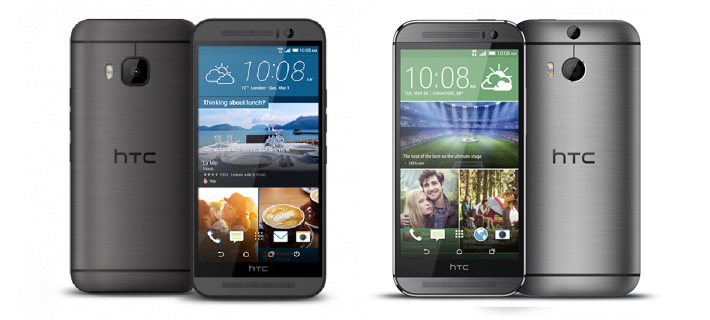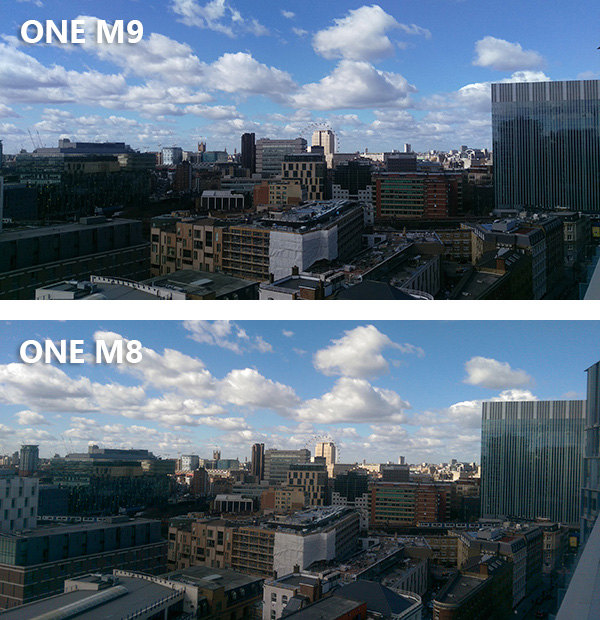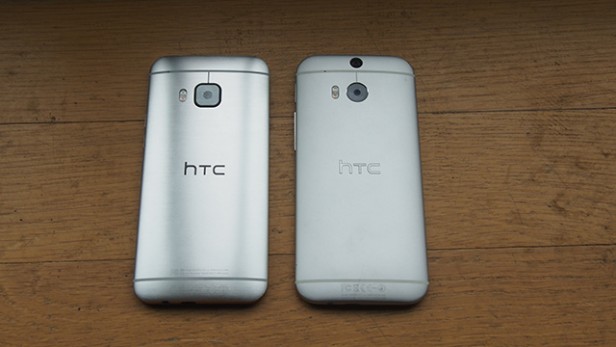
HTC recently released their flagship phone for 2015, the HTC One M9. From the outside the One M9 looks very similar to its predecessor, the One M8, but there’s more here than meets the eye. Let’s take a look at how these two phones stack up inside and out, in our HTC One M9 vs HTC One M8 comparison!
| HTC One M9 | HTC One M8 | |
| Display | 5-inch 1080p IPS | 5-inch 1080p IPS |
| Cameras | 21 MP / 4 MP | Dual 4 MP / 5 MP |
| CPU | Snapdragon 810 Octa | Snapdragon 800 Quad |
| RAM | 3GB | 2GB |
| Storage | 32GB + micro SD | 16 / 32GB |
| Battery | 2840 mAh (62 hr endurance) | 2600 mAh (77 hr endurance) |
| Android | 5.0 Lollipop + Sense | 5.0 Lollipop + Sense |
| Design | Aluminium unibody Gunmetal, gold on silver, gold |
Aluminium unibody Gray, silver, gold |
Design
The One M9 continues the legacy of the One M8 and One M7, with its handsome aluminium unibody design and dual front-facing speakers. That makes for a rather tall phone, but it does feel solid in the hand and looks great. The only issue is that all the changes from One M7 to One M9 are incremental; to a casual observer the phones look and feel identical.
A few small changes have been made if you look closely though – the lock button has been relocated from the top of the phone to the right-hand side, which is definitely an improvement in ergonomics. The edges of the phone are also a bit sharper and the finish is shinier, which makes the phone a bit less slippery in the hand.
Design verdict: Small improvement
Hardware
When it comes to hardware, we see improvements across the board as we’d expect. The One M9 has Qualcomm’s latest Snapdragon 810 octa-core processor, compared to the Snapdragon 801 quad-core that came in the One M8. Storage space has also doubled on the cheapest model, from 16 to 32GB, and micro SD card support remains.
The battery has also been increased in capacity, up to 2840mAh, although somehow battery life is lower. GSMArena report a total of 62 hours in their three-part endurance test, compared to 77 hours on the One M8. 3G talk time has gone way up, but web browsing and video playback have gone down – a surprising result given the 11% larger battery.
In one critical area, we’ve seen a regression: the display. While both phones include an IPS display that’s five inches across and sits at 1920 x 1080 resolution, the quality control of the One M9 seems to be markedly worse. Many sites reported poorly calibrated displays, leading to worse colour accuracy and contrast figures. Viewing angles were also not as good as on the One M8.
Hardware verdict: A mixed bag
Camera
The One M9 has a massive 20.7-megapixel sensor, behind a f/2.2 aperture and with dual-tone LED flash. That’s pretty much the opposite approach to the One M8, which came with a pair of 4-megapixel sensors and an f/2.0 aperture.
Moving from a pair of large sensors with a low megapixel rating to a single smaller sensor with a much higher megapixel count has changed the phone’s camera capabilities considerably. The high megapixel count on the One M9 is better for well-lit subjects and landscapes, but the small sensor size means that low-light performance isn’t as good. You also lose the unique capabilities provided by the dual lenses in the One M8, such as background blur and after-shot refocusing.

Camera comparison, via TrustedReviews
When it comes to the front-facing selfie cam, we also have differences. HTC’s phone uses the 4-megapixel Ultrapixel sensor that was on the back of last year’s model, while the One M9 comes with a higher resolution but less advanced 5-megapixel unit. In general, the new front-facing camera does produce better photos, particularly in low light.
Overall, the camera changes seem to make sense here. The One M8’s dual-sensor system was interesting, but never really produced stunning photos. Moving back to a high-megapixel sensor, and including whatever software innovations they’ve learned over the past couple of years, seems to have worked well for HTC.
Camera verdict: Big improvement
Software & features
The One M9 and One M8 both feature HTC’s Sense interface, and both phones run Android 5 (the One M9 out of the box, and the One M8 after an OTA update). Consequently, there aren’t too many massive differences here.
Blinkfeed has been upgraded in the new version; it now suggests nearby places to eat when you normally go for lunch or dinner. HTC also added themes to the new version of Sense, letting you easily customise the look of your phone right out of the box.
Generally, if you liked Sense on the One M8, you’ll like it on the One M8 too.
Software and features verdict: Small improvement
Conclusion
The One M9 is a strong Android phone, with a few small upgrades here and there to differentiate it from its predecessor. The camera is probably the largest single difference, so if you take a lot of photos then you’ll definitely want the One M9. The other differences are more minimal (and there are even some regressions), so if you can find the One M8 for a great price then it might be prudent to take it.
Would you rather have the One M9 or the One M8? Let us know in the comments below! You can also reach us on Twitter @mobilefun!
